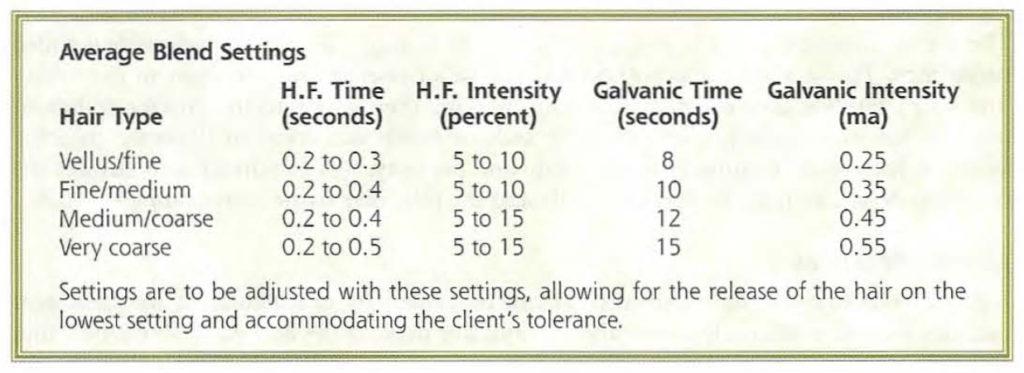The blend method is simply a combination of galvanic electrolysis and thermolysis, and consequently, it is marketed as combining the efficacy of galvanic electrolysis with the speed of thermolysis. However, the way electrologists talk about “the blend” would imply that it is a single method. There are, in fact, many ways to achieve a blend. Not only are the galvanic and thermolytic currents independently adjustable, there are possible variations in timing. One can apply both currents simultaneously, lead with one or the other, ramp the intensity up, pulse the currents, and so on. Consequently, your treatment with one blend operator may differ greatly when compared with another.
Why don’t you use blend?
Simply put, I don’t think the blend method is theoretically sound—or rather, I don’t see an additional benefit on top of purely galvanic electrolysis. I often see two main assertions about how the blend method works.
- The heat introduced by the high-frequency (thermolysis) current raises the temperature of the galvanic lye, causing it to dissolve either faster or with greater potency.
- The applied thermolysis disrupts the constitution of the tissue surrounding the follicle, making it more porous and allowing the lye to infiltrate the area more effectively.
With regard to assertion 1, a given amount of lye will dissolve a given amount of tissue, regardless of temperature. Increasing the temperature will increase the speed at which this occurs (both chemistry textbooks and electrology textbooks give a rule-of-thumb that increasing temperature by 10 C° will double the rate of a reaction), but it won’t increase the amount of material destroyed or consumed. This is beneficial, I suppose, if your electrologist has a compulsion to epilate each hair immediately after it is treated, but there truly is no need to do this. Just treat five hairs—ten hairs, even!—sequentially, allowing each to marinate in lye, before returning to extract any of them.
Assertion 2 makes more sense to me. Electrologists, in their training, have likely seen a clip from a James Schuster video, showing blend application in a cross-section of tissue. Shown is the formation of lye as the direct current (galvanic) is applied, then what appears to be a small explosion (really more of a puff) dispersing the lye as the thermolysis is applied at the end. However, one of my goals as an electrologist is to minimize trauma to the skin. I see no need to widen the blast radius inflicted by my needle when I can achieve quality removals without.
How is blend electrolysis commonly practiced?
Both of these assertions in the previous question imply the blend method to be a predominantly galvanic means of destroying hair. The main destructive agent is lye, and its action is augmented in some manner by a small amount of heat. However, in my experience, the way most electrologists use blend would appear to be simply thermolysis with a little bit of galvanic lye added for good measure. In fact, this is generally how many of us are taught to approach blend: first, establish slow thermolysis settings that cleanly epilate the hair in under ten seconds (“establish the working point”), then add an additional amount of lye equal to one-quarter the amount you would use if doing galvanic electrolysis. This sort of technique tends to be marketed as “fast blend” or some similar term, taking place in about three to five seconds, hardly enough time for any substantial amount of lye to be created. Additionally, it’s common to lead such a treatment with thermolysis, then follow with galvanic. Heat applied to tissue dissipates relatively quickly, and so applying it before any significant lye formation means that no lye is being heated.
Why not use a high-galvanic blend?
Confusingly, the textbook in use in California’s major electrolysis schools endorses the high-thermolysis method mentioned in the previous section. Then, later in the chapter, it provides the following, galvanic-dominant table.

These are relatively mild flash settings—fractions of a second at low intensity—followed by a lengthy galvanic pulse. In fact, the galvanic portion of these settings is not far off from how I remove hair. For example, my very coarse neck hair was effectively killed with 0.7 mA applied for 13 seconds. This manner of blend simply does not offer any improvements in speed; therefore, I see no reason to use it.
That being said, it’s much easier to find a blend operator than a galvanic operator. An electrologist using a manual blend machine or a computerized one that allows full control over the settings should be able to offer this sort of treatment—a long galvanic application followed by a bit of thermolysis. In fact, the trans women I know across the country who are pleased with their blend work seem to see electrologists who take about ten to twelve seconds to remove a hair. Find a blend electrologist, tell them to turn the thermolysis down and take it slow, and you should be fine.
What does blend scarring look like?
In general, because many electrologists are using blend settings which are near-identical to thermolysis settings, blend scarring tends to look like thermolysis scarring. One blend-specific phenomenon is what Schuster has termed “high-frequency blowout”. Too high a thermolysis setting can overheat the moisture in the tissue, causing a rapid expansion of steam and resulting in a pitted crater. I’ve seen these marks when looking over what I’m told is thermolysis work, so I’m not certain that they are unique to blend, but blend is the context in which the concept is generally introduced in an electrolysis curriculum.